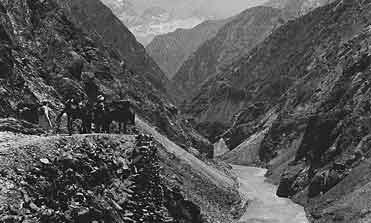It may presently be one of the most God-forsaken places on our planet. The Kokcha River region of Afghanistan is good for little more than opium farming and arms smuggling today, though it was once one of the great corridors between the ancient worlds of India and Iran, long before Darius and the Persian Empire.
As early as five thousand years ago, the Pharaohs of Egypt traded for the precious, bespangled lapis lazuli that is still mined from the mountains that are still being excavated by the River Kokcha.
It is the River Kokcha that defines, more than any other stream, the natural boundary between the Pamir and the Hindu Kush. Because of this strategic significance of the river, it must have competed with Khyber Pass for traffic between ancient India and Bactria. This is corroborated by Franz Grenet, who draws clues from the Avesta that indicate that the River Kokcha may have been the major route between Bactria and India at one time. The Avestan pattern Ragha-Chakhra-Varena-Hapta Hendu appears to draw a course from the Panj (Oxus) to India by way of Chitral, Pakistan.
Grenet also suggests that the prophet Zoroaster may have been born and raised at a bend on this river. Alexander the Great would later found his city Alexandria on the Oxus at the mouth of the Kokcha, after he crossed into Bactria from India, likely by way of Dorah Pass, at the headwaters of the very same river, at the junction of the Hindu Kush and the Pamir massif, the “Roof of the World.”
Long after Zarathustra and Alexander, Marco Polo claimed to have traveled along this same river, seeing the fabled lapis lazuli mines, on his way to China:
From Hormuz to Kerman, passing Herat, Balkh, they arrived Badakhshan, where Marco Polo convalesced from an illness and stayed there for a year. On the move again, they found themselves on “the highest place in the world, the Pamirs”, with its name appeared in the history for the first time.
Even today, the majority of Afghans are Iranians. The Tajiks, who speak Persian, are about as Iranian as anybody—”Tajik” is just another word for “Iranian”. Though Uzbeks have ruled and settled the area from time to time, the Kokcha River region is primarily Tajik country. The land immediately across the passes at that boundary between the Pamir and Hindu Kush is called Kafiristan, which may translate, curiously enough, to “Land of the Infidels”. This is a subject of some dispute. It would seem to be apropos, given the great religious divides that must have existed between East and West back into the depths of human prehistory, but perhaps more important than the divisive aspect of these geo-religious differences might be the enlightening aspect of cultural cross-pollination between early Hindus, Zoroastrians, Greeks, and Buddhists over so many centuries.
